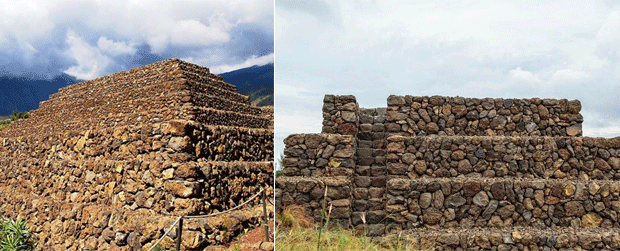|
The pyramids are certainly some of the most
mesmerizing historical structures in recorded history. The fact that
makes pyramids a unique attraction among the history freaks and
travelers is that these structures were made in the period when there
was no luxury of machines and technology support.
|
|
The Great Pyramid of Giza:
Listed among the Seven Wonders of the World, the great pyramid of Giza
is the oldest of such structures ever found. This structure is also
known as the Pyramid of Khufu. It is believed that this tomb was
constructed around 2560 BC. There are many scientific theories about the
construction of this pyramid. There are three chambers inside this
structure. The edifice was built on the lowest chamber, which is cut
into the bedrock. The higher chambers are known as the king's chamber or
the queen's chamber. It is the only Egyptian pyramid containing both the
descending and ascending passages. |
|
 |
|
Nubian Pyramids:
The region of Nile Valley is known as Nubia and thus the pyramids found
in that area are known as Nubian Pyramids. The emperors of ancient
Kushite Reign constructed these structures. There are around 255
pyramids constructed eventually at three areas in Nubia. These three
sites are El-Kurru, Nuri and Meroe. These structures were made of
stepped courses of stone blocks positioned horizontally and are in
elevation of six to thirty meters. Most of such edifices are temple
structures. |
|

|
|
Pyramid of Hellinikon:
Pyramid of Hellinikon is a leftover of mysterious pyramids of Ellinika,
which is an ancient city of Greece. This structure is said to be the
military base of that time. Other theory tells that this pyramid was
built as the memorial for the martyrs of the battle. It is made up of
pure rock, which does not comprise polishing. These rocks are from
Mycenean era (1600 BC- 1000 BC). The pyramid served as a place of burial
and was first excavated by Germans and Americans. |
|

|
|
Pyramids of Güímar:
Pyramids of Guimar are the six structures located in the Chacona
District of Guimar in Canary Islands. These structures are rectangular
and terraced in shape and are made up of lava stone without taking the
use of mortar. There were nine pyramids in Guimar, among which only six
maintained to survive. The archeologists believe that the construction
of the terraces in these structures is the result of practices of the
native rural population of primeval period. These people created these
edifices while clearing the stones of cultivable land and pilled the
stones in the shape of terraces. |
|
 |
|
Great Pyramid of Cholula:
The great Pyramid of Cholula is also known as Tlachihualtepetl, which
refers to artificial mountain. It is situated in the Cholula of Mexico.
This edifice is a temple structure that is traditionally believed to be
dedicated to Quetzalcoatl God. There is a slight influence of Gulf Coast
in the construction of this pyramid and is closely linked to the
architectural style of Teotihuacan. In the prehispanic times, this
pyramid was an imperative mythical and religious center.
|
|
 |
|
Pyramid of the Sun:
It is one of the largest constructions in Mesoamerica and is the largest
in Teotihuacan. This pyramid is the fraction of large complex situated
in the heart of city. It is positioned along the Avenue of Dead, right
in the middle of Ciudadela and the Pyramid of moon. It is in the shadow
of splendid Cerro Gordo Mountain. The orientation of this pyramid marks
an archeological significance. It is oriented a bit towards northwest of
the horizontal point related to the setting of the sun. It is believed
that there was a temple on the top of the pyramid.
|
|
 |
|
Pyramid of Cestius:
It is an ancient pyramid of Rome. This structure in positioned near the
Protestant Cemetery and San Paolo. The research shows that this pyramid
was built in the 18 BC-12 BC. It was a tomb of Gaius Cestius, who was a
member of Septemviri Epulonum (one of the four great spiritual
corporations in Rome). This edifice is included in the fortifications of
the city; hence, it is among the best-preserved ancient constructions
found in Rome. There are different historical inscriptions found on this
structure. |
|
 |